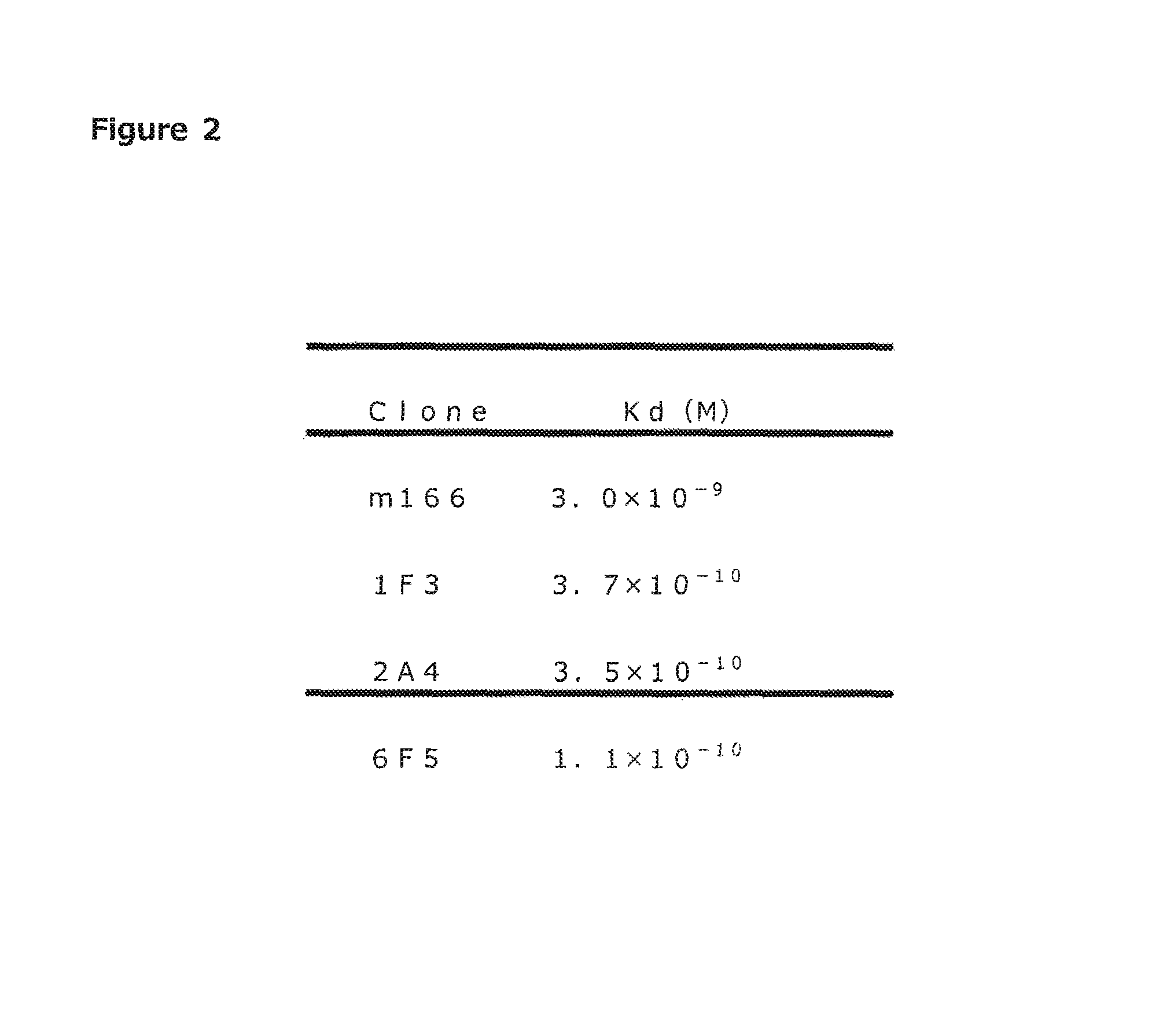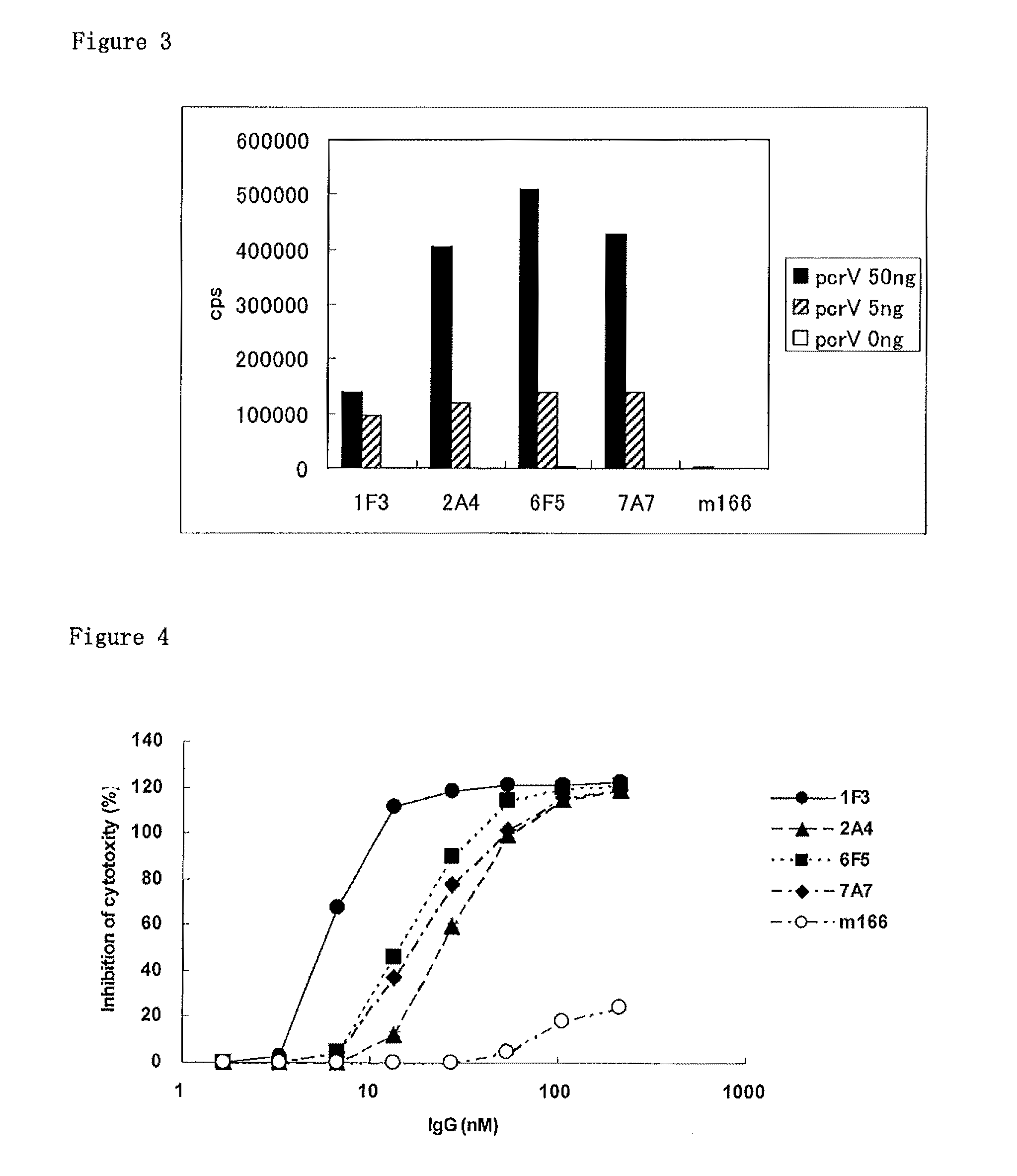Antibody against PcrV
a technology of monoclonal antibodies and antibacterial agents, applied in the field of monoclonal antibodies, can solve the problems of difficult cure, limited measurement of the development of new antibiotics one after another, and the difficulty of humanizing polyclonal antibodies, and achieve excellent neutralizing activity of pcrv
- Summary
- Abstract
- Description
- Claims
- Application Information
AI Technical Summary
Benefits of technology
Problems solved by technology
Method used
Image
Examples
example 1
[0096]Preparation of Antigen
[0097]Chromosome DNA of Pseudomonas aeruginosa standard strain PAO1 provided from Tokai University, Japan, was extracted, and gene encoding PcrV protein (SEQ ID NO: 2) was amplified by PCR using the DNA as a template. A recognition site of restriction enzyme SphI was provided in 5′-side primer and a recognition site of restriction enzyme HindIII was provided in 3′-side primer, (SEQ ID NOs: 3, 4), and in insertion into an expression vector a design was made so that cysteine is inserted between histidine tag and start codon for biotin labeling. The amplified PCR fragment was cloned into pWE30 vector (available from GE healthcare) at SphI and HindIII sites. After sequencing, the vector was introduced into E. coli JM109 to obtain recombinant E. coli (PcrV-JM109). PcrV-JM109 was cultured in 500 mL of LB / Ampicillin liquid culture medium at 37° C., and when OD600 reached 0.5, IPTG was added to a final 0.75 mM. After culturing at 37° C. for additional 1.5 hours, ...
example 2
[0108]Binding Activity of Antibody
[0109]For measuring binding activity of antibodies (1F3, 2A4, 6F5, 7A7), competitive immunoassay was performed. Each well of a 96-well microtiter plate (available from Nunc) was added with 100 μL of tris buffer (50 mM Tris-HCl, pH7.5) containing 1.5 μg of anti-mouse Fc antibody (available from Jackson ImmunoResearch) and immobilized for 16 hours at 4° C. These wells were washed twice with 300 μL of washing solution, then added with 300 μL of blocking solution and left for two hours at room temperature to achieve blocking (anti-mouse IgG antibody solid-phased plate). After washing twice with 300 μL of washing solution, 2 ng / well of each antibody and non-labeled PcrV at five concentrations in 10-fold dilution series from 500 ng / well were added. Then, 5 ng / well of biotinylated PcrV was added and allowed to react overnight. After washing four times with 300 μL of washing liquid and adding with 100 μL / wel of Enhancement Reagent (available from PerkinElme...
example 3
[0112]Sandwich Immunoassay with Mab166
[0113]In order to prove that 1F3, 2A4, 6F5 and 7A7 have a different epitope from that of Mab166, sandwich immunoassay between each antibody and Mab166 was examined.
[0114]First, Mab166 was labeled with biotin. One hundred μg of Mab166 and 7.853 μg of NHS-PEO4 Biotin (available from PIERCE) were mixed in 0.1M PBS (pH 7.4), and allowed to react for 2 hours on ice. Thereafter, biotinylated mAb was purified by size exclusion chromatography (G2000SW column (available from TOSOH)) to remove unreacted biotin from the reaction solution.
[0115]Sandwich immunoassay was performed as follows. Each well of a 96-well microtiter plate (available from Nunc) was added with 100 μL of PBS (−) solution each containing 500 ng of PcrV antibody (1F3, 2A4, 6F5, 7A7) and immobilized for 16 hours at 4° C. These wells were washed once with 300 μL of a washing solution, then added with 300 μL of blocking solution and left for two hours at room temperature to achieve blocking...
PUM
| Property | Measurement | Unit |
|---|---|---|
| dissociation constant | aaaaa | aaaaa |
| pH | aaaaa | aaaaa |
| molar ratio | aaaaa | aaaaa |
Abstract
Description
Claims
Application Information
 Login to View More
Login to View More - R&D
- Intellectual Property
- Life Sciences
- Materials
- Tech Scout
- Unparalleled Data Quality
- Higher Quality Content
- 60% Fewer Hallucinations
Browse by: Latest US Patents, China's latest patents, Technical Efficacy Thesaurus, Application Domain, Technology Topic, Popular Technical Reports.
© 2025 PatSnap. All rights reserved.Legal|Privacy policy|Modern Slavery Act Transparency Statement|Sitemap|About US| Contact US: help@patsnap.com



